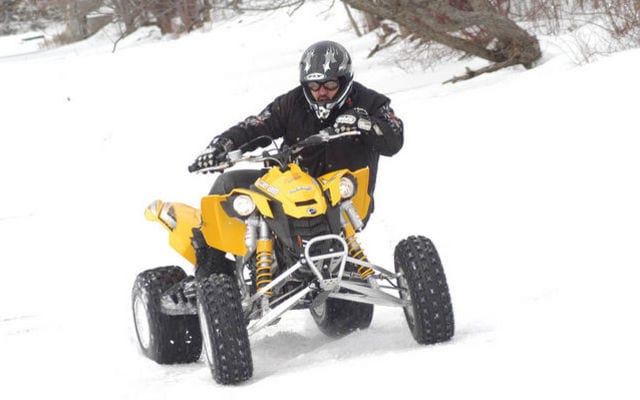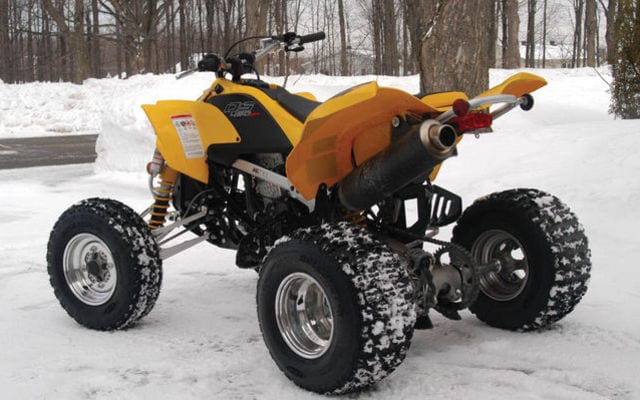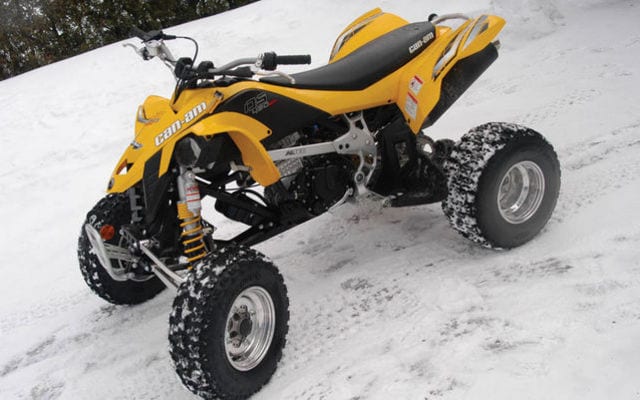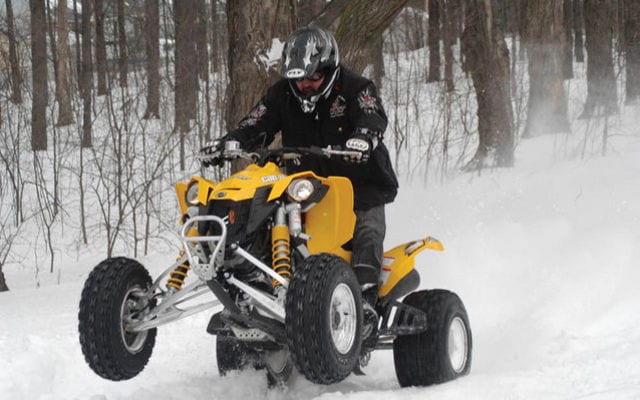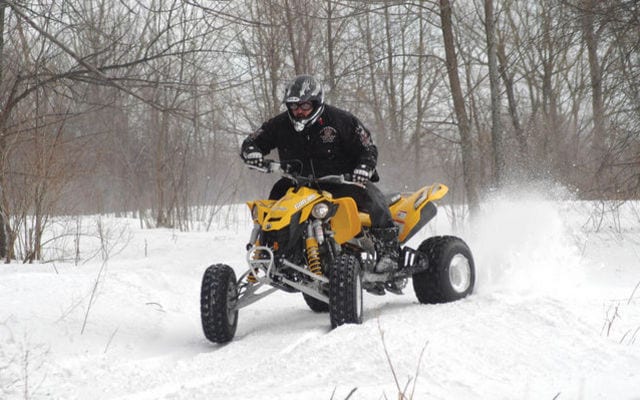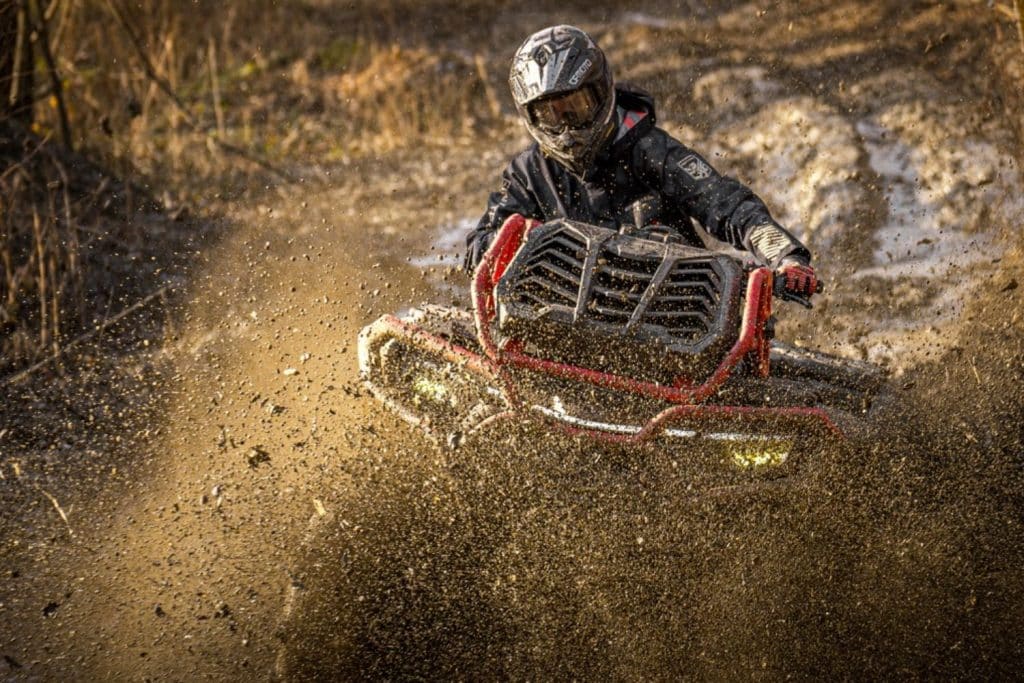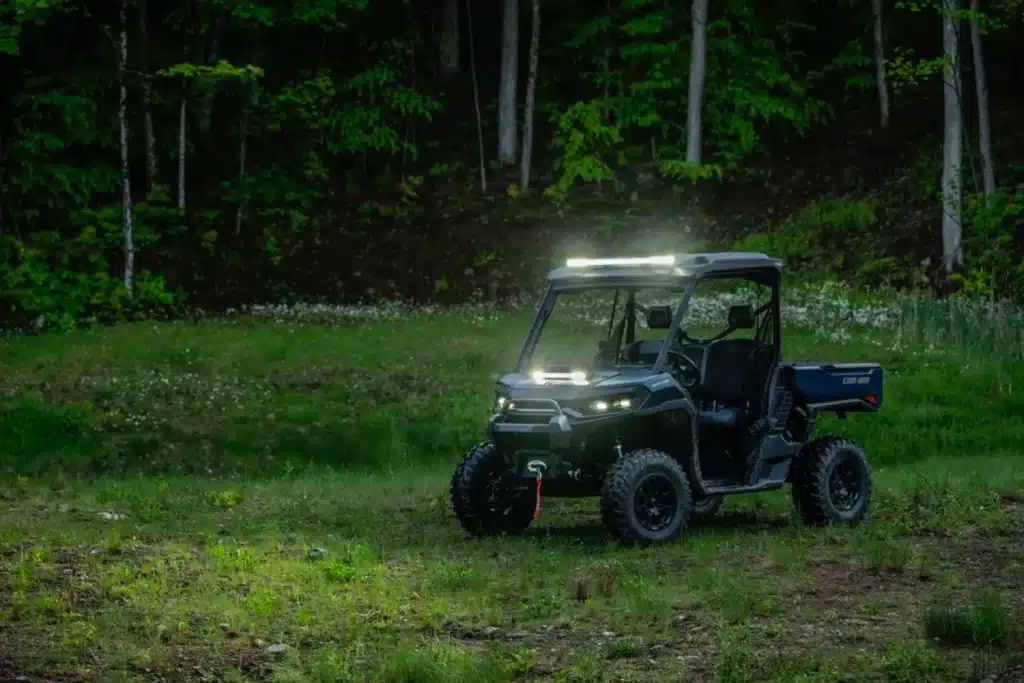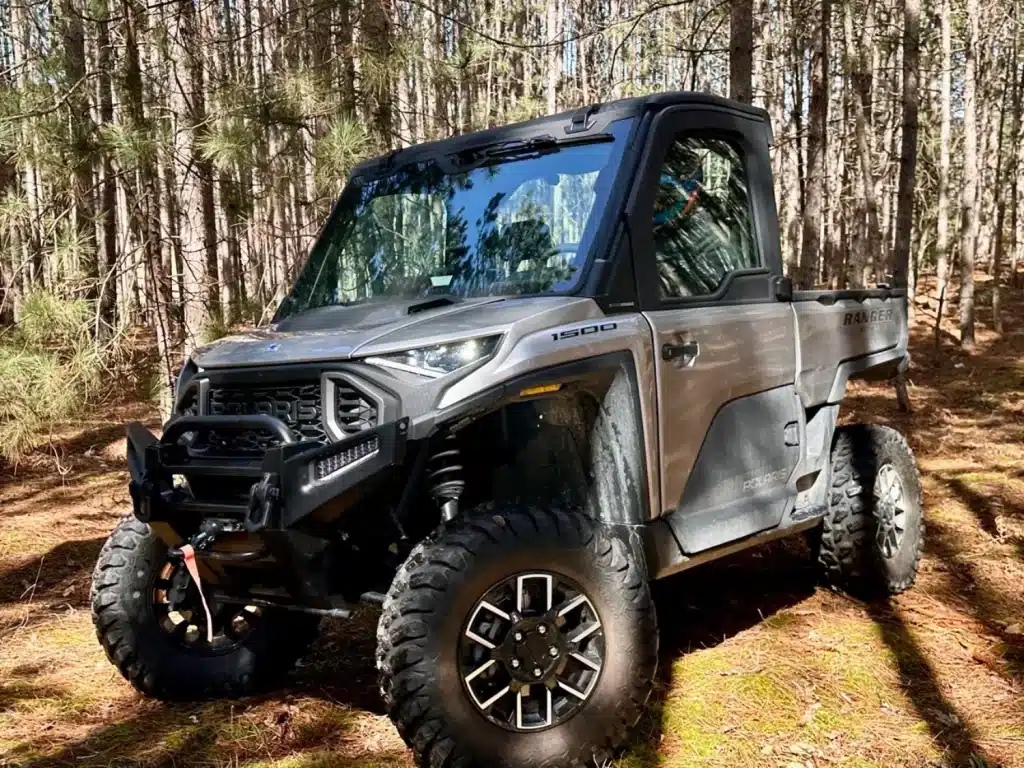Simply put, this is an absolutely wonderful quad. From a very first glimpse, you can tell a lot went into making this a strong contender on racetracks. I admit that mid-February isn’t the best time to test this soon to be racing legend, but how could I pass up on the opportunity to ride it? Even if this is a racing machine, many will buy it for fun riding. Despite the freezing cold, the violent winds and the falling snow, all of me wanted to ride it.
The beautifully designed 2008 Can-Am DS450 was anxiously waiting for me to bring it to life, willing to put out all it’s capable of, or rather whatever I can manage in these extreme conditions. Just lying there in my garage, it just didn’t seem happy.
It is at its most beautiful while in action, as this one was designed with one simple goal; winning races. Entering the sport with a bang, BRP’s new jewel was showcased for the very first time at the Montreal Supercross last September where Ontario’s promising young rookie Greg Gee, did an amazing job at bringing it up on the podium in second place. Coming into this competitive world of racing also as a rookie, this amazing little machine carries the heavy burden of positively representing the whole of BRP’s product line.
I spent a strangely long time just looking at it. Every detail was scrutinized by instinct, and its conception analyzed too much. By now, if the practical electric start button could talk, it would be screaming at me, ”come on, and press me already!” But I’m noticing some ingeniously added advantages. I’m still busy discovering details like the front brake lever, which has a small five position dial that allows bringing it closer or further from the grip to fit different finger sizes. On this same lever, the park brake is also well made as it was very quick and easy to engage. A neutral position indicator is a practical addition to this type of quad, racers will be glad to know that there is no need to find neutral to restart though, holding the clutch lever will suffice.
It was built with a few simple things in mind: go fast and go faster. These objectives seem like they’re simple enough right? But the competition is fierce in the racing world and coming in as a rookie and performing well right off the bat is no easy task. It seems that this baby has a good chance with its innovative designs many years in the making.
Just riding it, without the pressures of performing for an audience or fighting to reach or keep first place in a race, is an absolute joy. I had my ATV-riding prodigy friend Fitto, drooling after just a few thumb happy minutes of riding it sideways, standing on its hind wheels. We were taking turns at throwing this featherweight in all directions in and around the tiny frozen St-Jean River close to home. His first comment was very telling: “I’ve got to get me one of those!”
So there I was at the start of a trail I’ve had the pleasure of riding since my very young years. Looking out at the thick blanket of snow, the trail was barely still visible. Anyone in their right mind wouldn’t think of attacking this trail with a two-wheel drive. But hey, it’s me, and despite the stock tires I threw myself in there without putting much thought into it. Ok, so I did get stuck in the snow a few times, but who cares, I was picking that back end up and throwing the quad out of the foot deep ruts with hardly any effort. Release of the clutch lever was a little tricky as only about a centimetre of play is used to engage the motion. Playing it just right, I was off again without digging back in the snow, but it was a challenge. Once I got going, I could manage fine, clearing stretches of deeper snow by gunning it and shifting up a few gears. I quickly realized that having somebody to follow or flatter packed snow conditions would just be much more fun. Anyway, these were totally not recommended conditions for this quad which should be driven only by experienced riders, even more so now in these conditions.
With my friend Martin on his DS650 Baja on “four snow” tires up ahead, my fun factor skyrocketed. Once off and up a few gears, the smooth ride was amazingly easy despite the drag of the thick white blanket. The whole package is so light and well balanced that riding it aggressively comes naturally. I was very impressed with the availability of power, even at low rpm’s. Leaving it in third gear was no problem; I could negotiate every tight curve and scream out without ever downshifting. I just couldn’t believe how well the machine was behaving in these conditions without snow tires.
Let’s talk about what went into this very technologically advanced machine. First off, it’s the lightest of its class, weighing in at a mere 161 kg (345 pounds). Perfect centralization of this weight was also a critical goal. This was the designers’ first priorities and the result is superb control and balance, both in flight and on the ground.
The A-arms seem like toothpicks at first glance, but a closer look reveals ingeniously T-shaped forged aluminum with a precisely calculated gradual augmentation of material only towards the thicker key points needing more strength. The frame design is narrow for maximum a-arm length, but on top of that, BRP engineers innovated once more with brake calipers tucked in deep inside the wheels so that the A-arms could be longer. KYB shocks do a great job at absorbing huge bumps with rebound, compression, and preload adjustable.
Aluminum was of course the choice material for as many parts as possible, for its good strength to low weight ratio. The true magic is in the way they managed to make room for extensive use of this now crucially used material. Shortening the beefed up and hollowed out axle so that the lighter aluminum wheels hubs are made longer reaching further inside.
The Can-Am team was very bold in their frame design. The double pyramidal layout is weld less to keep strength at a maximum. A combination of cast, extruded, and stamped pieces joined with aerospace-grade fasteners and regular nuts and bolts are used to connect everything together. This way, thermal weakening caused by welding is avoided. Each straight beam transfers forces to others and so on and the entire structure works in unison to absorb surprisingly high charges more efficiently. Forces are absorbed by perfect distribution of tension and compression throughout the frames straight beams. Of course the other advantage is that these beams are removable for servicing or replacement.
The 4-TEC 450 EFI Rotax powerplant is very powerful and smooth. The top end was based on the Aprilia RSV 1000 R sport bike. It uses the same free-flow intake design with dual sparks plugs. The intake valves, bore, and throttle body are the largest of the 450’s so the potential to modify this engine is huge.
The most powerful, lightest, and most centralized mass of all 450s is sure to have a huge impact on the racing scene. But the fact is many others will let themselves be tempted by its intense trail riding capabilities. Those who rode its late uncle the DS650 will be more than happy to switch to this lighter and faster masterpiece of engineering. For serious play, or fun racing, this one is sure to satisfy all your high performance needs. Enjoy!
For more information on the above mentioned models, please visit the Can-Am Off-Road Website
More from Can-Am on ATV Trail Rider :
Can-Am ATV Models – Can-Am UTV Models – Can-Am ATV Reviews – Can-Am UTV Reviews


